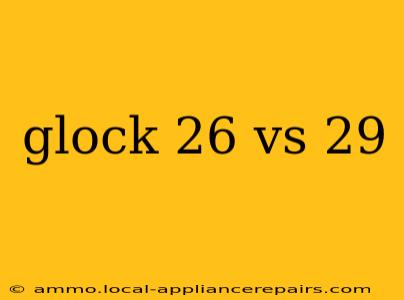Choosing between the Glock 26 and Glock 29 often comes down to personal preference and intended use. Both are popular subcompact handguns known for their reliability and ease of use, but they cater to different needs and priorities. This in-depth comparison will help you decide which Glock best fits your requirements.
Caliber: The Core Difference
The most significant difference lies in caliber. The Glock 26 is a 9x19mm (9mm Luger) pistol, while the Glock 29 chambers the potent 10mm Auto cartridge. This immediately impacts recoil, felt muzzle blast, and effective range.
-
9mm (Glock 26): Offers lower recoil, making it easier to shoot accurately, especially for beginners or those with smaller hands. Ammunition is widely available and relatively inexpensive. 9mm is a versatile round suitable for self-defense, target practice, and concealed carry.
-
10mm (Glock 29): Delivers significantly more stopping power than 9mm. The larger cartridge generates considerably more recoil, requiring more practice to master. Ammunition is generally more expensive than 9mm. The 10mm is a powerful round ideal for self-defense against larger threats, though recoil can be challenging.
Size and Weight: A Subtle Discrepancy
While both are subcompacts designed for concealed carry, there are subtle size and weight differences. The Glock 26 is generally considered slightly smaller and lighter, contributing to greater concealability. However, the difference is marginal and may not be a deciding factor for many users.
Capacity: Ammo Considerations
Magazine capacity is another area of consideration. While both pistols can accommodate extended magazines, the standard magazine capacity is typically lower in the Glock 29 due to the larger 10mm cartridge.
Recoil and Shootability: A Significant Contrast
The recoil difference is substantial. The Glock 26's 9mm round is significantly milder, resulting in easier and more comfortable shooting, even for extended periods. The Glock 29's 10mm recoil is noticeably stronger, demanding more practice to control and maintain accuracy. This makes the Glock 26 a more suitable choice for beginners and those prioritizing ease of handling.
Intended Use: Defining Your Needs
The best choice hinges greatly on your intended use:
-
Self-defense (general): The Glock 26 is an excellent choice. Its manageable recoil, widespread 9mm ammunition availability, and relatively high capacity make it a highly practical self-defense pistol.
-
Self-defense (against larger threats/wildlife): The Glock 29's superior stopping power makes it a better option for situations where confronting larger animals or multiple attackers is a possibility. However, the significant recoil necessitates extensive practice.
-
Concealed carry: Both are suitable for concealed carry, with the Glock 26 potentially offering slightly better concealability due to its smaller size and weight.
-
Target practice/range use: The Glock 26 is generally preferred for extended range sessions due to its lower recoil. The Glock 29 can be used, but the recoil may lead to fatigue.
Conclusion: The Verdict
There's no single "better" pistol; the ideal choice depends entirely on individual needs and priorities. The Glock 26 excels in ease of use, manageable recoil, and widespread ammunition availability, making it ideal for most self-defense scenarios and concealed carry. The Glock 29, on the other hand, offers superior stopping power at the cost of increased recoil and specialized ammunition. Carefully consider your specific needs and prioritize accordingly. Renting both at a shooting range before purchasing can be highly beneficial.

